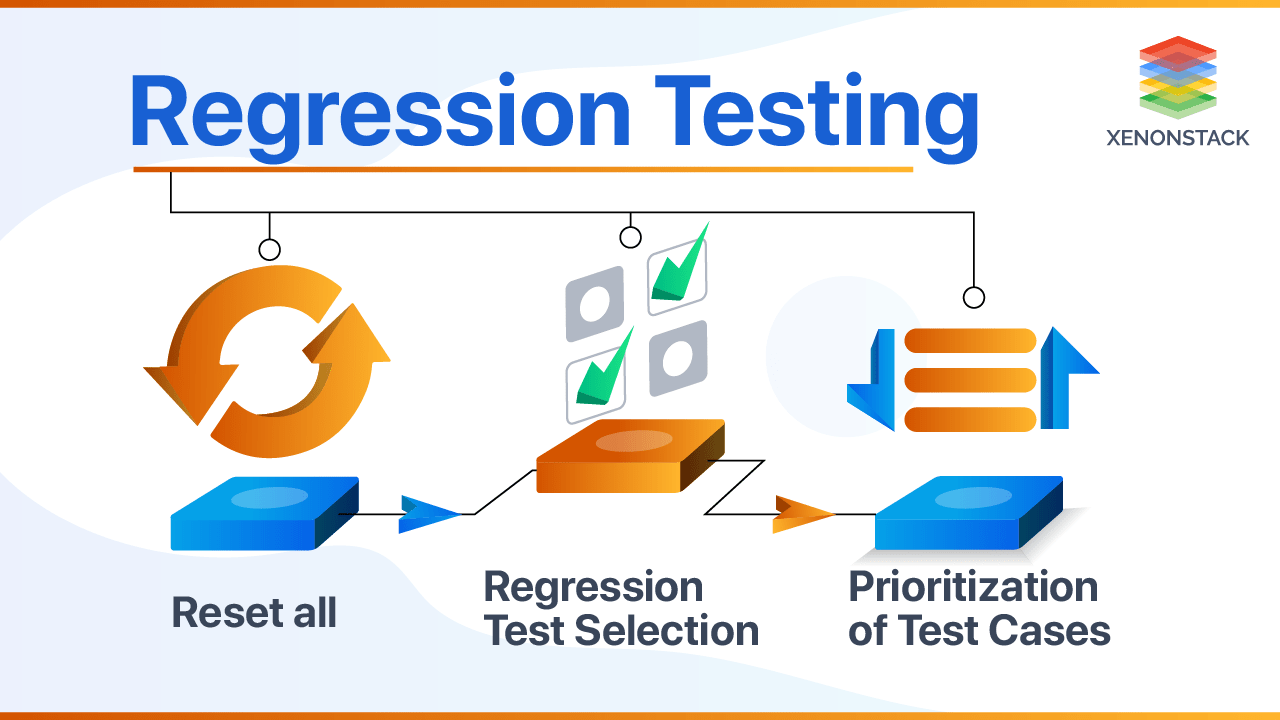
What is Regression Testing?
Regression testing is a software testing approach that verifies the stability of existing features after new updates or features are added. It aims to ensure that recent changes haven't caused any issues or "regressions" in the previously working code, confirming that old features remain unaffected by the new additions.
This type of testing may be necessary following various changes, including:
- Bug fixes
- Software enhancements
- Configuration adjustments and
- Even the substitution of electronic components (hardware)
Why should you perform regression testing?
Regression testing is crucial in the testing process because it helps identify if recent code changes or enhancements have introduced new defects or impacted existing functionality. Even small code updates can lead to costly errors without proper regression testing. It ensures consistent software quality by preventing the reappearance of known issues and boosts confidence in the overall stability of the application.
What are the types of Regression Testing Techniques?
Below are the types of regression testing techniques:Retest All
One method of this testing is to re-execute all tests in an existing test bucket or suite. This is costly as it requires enormous time and resources.
Regression Test Selection
Instead of re-executing an entire test suite, it is better to select a part of the test suite to run - Test-chosen cases are categorized as
- Reusable Test cases
- Obsolete Test cases
Prioritization of Test cases
To prioritize test cases depending on a business impact, critical and frequency used functionalists. The selection of test cases based on priority will significantly reduce the regression test suite.
Continuous Testing is a procedure of testing early, testing regularly, test everywhere, and automate testing on a continuous basis. Source: Continuous Testing in DevOps
How does Regression Testing Work?
It is done manually. However, as application development takes time, more and more functionality keeps increasing the scope of regression; therefore, this Testing is executed in an automated way. While preparing a test suite for regression, consider the following -
-
Automate all the test cases of a test suite.
-
Update the regression suite whenever required. For example, if a new defect not covered in a test case is found, update the test case for that issue in the test suite. Perform Testing for a bug and uncover it next time.
-
Execute regression test cases whenever changes are made in code, perform bug fixing, create new functionality, and enhance existing functionality.
-
Create a test execution report that includes the pass/fail status of executed test cases.
What are the benefits of Regression Testing?

Prevents the Domino Effect
Even seemingly minor code changes have the potential to disrupt crucial functionalities of the product. Regression testing plays a vital role in detecting these issues at an early stage, allowing teams to address them proactively

Aligns with Agile Practices
Regression testing supports Agile workflows by enabling continuous code iteration, integration, and testing. This process encourages frequent releases and faster feedback, reducing the risk of issues building up before the release
The variety of methods, tools, and practices used to justify that a software application works at many different levels or not. Source- Automation Testing
What are the best practices for regression testing?
To do this testing, select test cases in the best way. Best Practises are as follows -
-
Include a Buffer Day: Regression testing can be time-consuming, and unexpected delays may arise. Allocating a buffer day allows you to handle unforeseen issues without compromising the quality of the release.
-
Test in a Production-Like Environment: Perform regression testing in an environment that closely mimics the production setup. This helps uncover issues that may arise from database size or system configuration.
-
Know When to Stop Testing: If you identify numerous issues early in a regression cycle, assess whether to continue or halt testing to address the problems before proceeding.
-
Clearly Define the Scope: Establish a clear scope for regression testing to ensure all critical features and functionalities are thoroughly evaluated.
-
Automate Whenever Possible: Leverage automated testing tools to speed up the regression testing process and minimize the risk of human errors.
-
Prioritize Test Cases: To streamline the testing process, focus on test cases based on their importance and potential impact on the software.
-
Use Real-World Scenarios: Test the software using user behaviour scenarios to ensure it meets end-user expectations.
-
Reuse Existing Test Cases: Save time and resources by reusing previously created test cases that are still relevant.
-
Start with a Smoke Test: Conduct a smoke test before running extensive test cases to identify major issues and prevent unnecessary resource expenditures.
Types of Regression Testing
Although each test shares the common objective of uncovering bugs, flaws, and issues, they do so through diverse methodologies and application scenarios:
|
Type of Regression Testing |
Description |
|
Corrective Regression Testing |
Uses existing test cases when no changes are made to product specifications, ensuring functionality remains intact. |
|
Retest-All Regression Testing |
Re-tests all system components from scratch, used when there are significant changes or potential overlooked issues. |
|
Selective Regression Testing |
Focuses on specific code areas affected by recent changes; selects a subset of test cases for efficient testing. |
|
Progressive Regression Testing |
It involves creating new test cases for changes in product specifications and testing new and existing functionalities together. |
|
Complete Regression Testing |
Conducted after major updates or alterations in core components, ensuring all aspects of the application functioned correctly. |
|
Partial Regression Testing |
Validates new code integration with existing code post-impact analysis, focusing on specific modules rather than the entire system. |
|
Unit Regression Testing |
Tests individual units in isolation to verify that internal changes do not impact the unit's behaviour or interactions. |
What are the best Regression Testing Tools?
To do it manually leads to a waste of time and money. To save time and cost, an automated testing method was adopted. For this, some tools are mentioned as follows:
Selenium
-
Open Source: Free and accessible automation tool.
-
Browser Compatibility: Supports Chrome, Firefox, Safari, and Edge.
-
Language Support: Works with Java, Python, C#, etc.
-
Cross-Platform: Runs on Windows, macOS, and Linux.
-
Focus: Ideal for automating web app testing.
-
Community: Strong support with plugins and extensions.
-
Integration: Works well with CI/CD tools like Jenkins.
Ranorex Studio
-
All-in-One Solution: Supports functional and non-functional testing.
-
User-Friendly: Intuitive interface, suitable for all skill levels.
-
Cross-Platform: Tests desktop, web, and mobile apps.
-
Codeless Testing: Offers capture-and-replay features.
-
Reporting: Provides detailed, customizable reports.
-
Integration: Connects with Jenkins, Azure DevOps, etc.
-
Data-driven: Supports testing with various data inputs.
testRigor
-
AI-Driven: Automates test creation with AI.
-
NLP Support: Write tests in plain English.
-
Codeless: No programming is required for test creation.
-
Cross-Compatibility: Tests across browsers and platforms.
-
Self-Healing: Adapts scripts to UI changes automatically.
Sahi Pro
-
Browser Testing: Ensures performance across multiple browsers.
-
User-Friendly: Scriptless record and playback features.
-
Detailed Reporting: Tracks and analyzes test results.
-
Integration: Works with CI tools like Jenkins.
-
Scalable: Handles large test automation projects.
-
Flexible Scripting: Supports both scriptless and JavaScript-based testing.
Testlio
-
Global Testers: Access to a wide network of professional testers.
-
On-Demand: Flexible testing schedules for quick feedback.
-
Integrated Platform: Manages execution and reporting in one place.
Final Thoughts
Regression testing safeguards software updates, ensuring new changes do not introduce unexpected issues. It involves selecting test cases from existing suites, often concentrating on modified code areas. Tools like Selenium and QTP help automate this process. Although it guarantees comprehensive testing, manual regression testing can be time-consuming and may face challenges related to data management.
-
Explore more about AI in Software Testing
-
Read more on Software Testing Best Practices
FAQ
How is Regression Testing Different from Other Testing Types?Regression testing focuses on ensuring that existing features continue to work correctly after code changes. Unlike functional or performance testing, which evaluate various aspects of software behavior, regression testing specifically checks for unintended impacts on previously functioning areas.
What are Regression Test Suites?
Regression test suites are sets of test cases used consistently during regression testing to verify the software's stability. These suites often prioritize critical test cases that cover essential functionalities of the application.
How to Measure the Effectiveness of Regression Testing?
The effectiveness of regression testing can be gauged using metrics like test coverage, defect detection rate, execution time, and the number of defects missed and found in production. Analyzing these metrics helps refine and improve the regression testing process over time.
.webp?width=1921&height=622&name=usecase-banner%20(1).webp)



